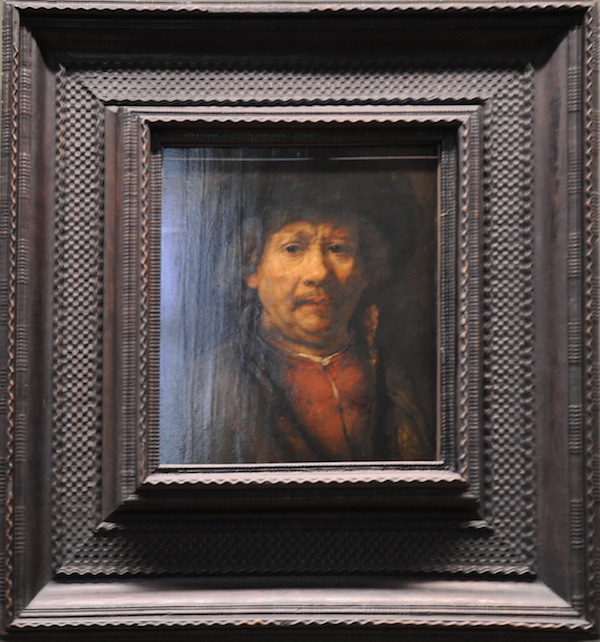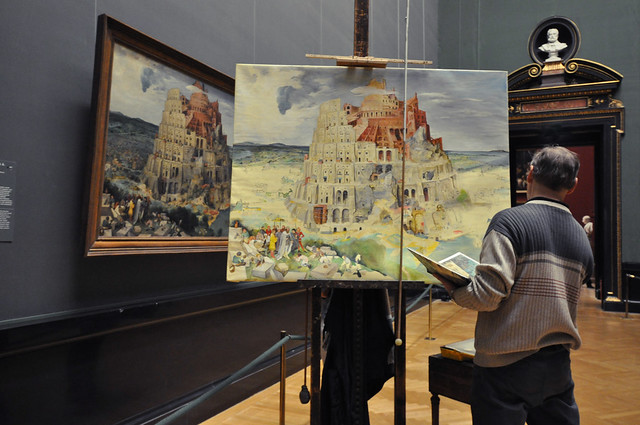
When you stare at a painting that is so well preserved, even though it is more than half a millennium old, when you look at the details so carefully that at some point all looks real... then you know you're looking at a great piece of art. A piece of history.
Kunsthistorisches Museum in Vienna holds a rich collection of remarkable paintings. Every single one tells a story. Some of them so intriguing, that I wanted to share with you.

Self-portrait in a Convex Mirror by Parmigianino
In 1524 Girolamo Francesco Maria Mazzola travelled to Rome seeking patronage of the Medici Pope, Clement VII. The young painter presented him with a small self portrait painted on a convex piece of wood. Although the painting was very small (only 24.4 cm in diameter) and the colour range was scarce, the concept was very clever and highly appreciated. Parmigianino was celebrated as a "Raphael reborn" and earned the patronage of the pope.

Flowers in a Wooden Vessel by Jan Brueghel the Elder
From 1600 on painting flowers developed into a separate category of still life. Jan Brueghel is one of the main representatives of this genre, with sixteen paintings of this kind attributed to him. He was nicknamed "Flower" and "Paradise" Brueghel because his floral still lifes. The "Flowers in a Wooden Vessel" is one of the most famous depictions of flowers ever created. What makes it special is that it is not a reflection of a real bouquet. It resembles an encyclopedic panorama of rare species. A virtuosic reproduction of 130 different flowers.

The Head of Medusa by Paul Rubens
With great cunning Perseus succeeded in killing Medusa, a monster whose hair consisted of snakes and whose gaze petrified all living creatures. At the time it was created (1617/18) the painting was understood politically or allegorically as a symbol of the victory of Stoic reason over the enemies of virtue.

Lot and His Daughters by Albrecht Altdorfer
"Lot and his Daughters" is one of the first nude depictions of German painting. It shows the biblical story of Lot's young daughters who get their father drunk in order to receive offspring from him. An earlier owner of the painting was ironically the Nurnberg advocate Nikolaus Gülchen, who was condemned to death in 1605 in charges of adultery, incest and rape.
 Small self-portrait by Rembrandt
Small self-portrait by RembrandtIn all his life, Rembrandt painted more than sixty self-portraits. They form a unique biography of the painter, documenting not only the conditions of his life, but also, and particular, his artistic development. Every painting is a piece of the puzzle of a real genius mind.

A Collection of Art and Natural Wonders by Hans III. Jordaens
The interior of the painting is a vivid example of the type of art cabinet picture popular in Antwerp (where Jordaens worked most). Natural objects like little stones and seashells fill the tables, as well as art objects like the different sculptures and vessels. Yet paintings dominate in this room: in the seventeenth century they increasingly became the focus of collectors' interests.

The Tower of Babel by Pieter Bruegel
Bruegel's monumental composition has become the most famous, most often copied and varied classic depiction of the tower. Even in present days, the painting interests artists from all around the world. Copying it may be challenging, even for those who are lucky enough to be able to paint in front of the original. This guy, however, is a true craftsman.
Oh Rembrandt, i have some posters in my house! I love the thick layers of paint and his bright colours!
ReplyDeleteI love art history for these reasons - there's always such a story behind everything!
ReplyDeletexo
http://kittysnooks.blogspot.com/